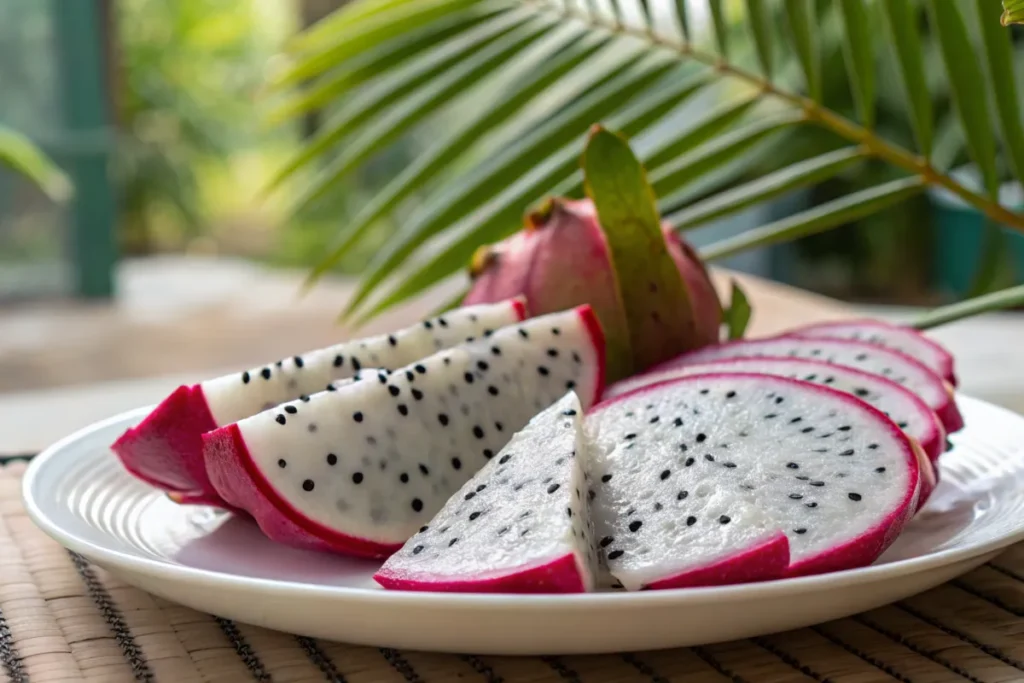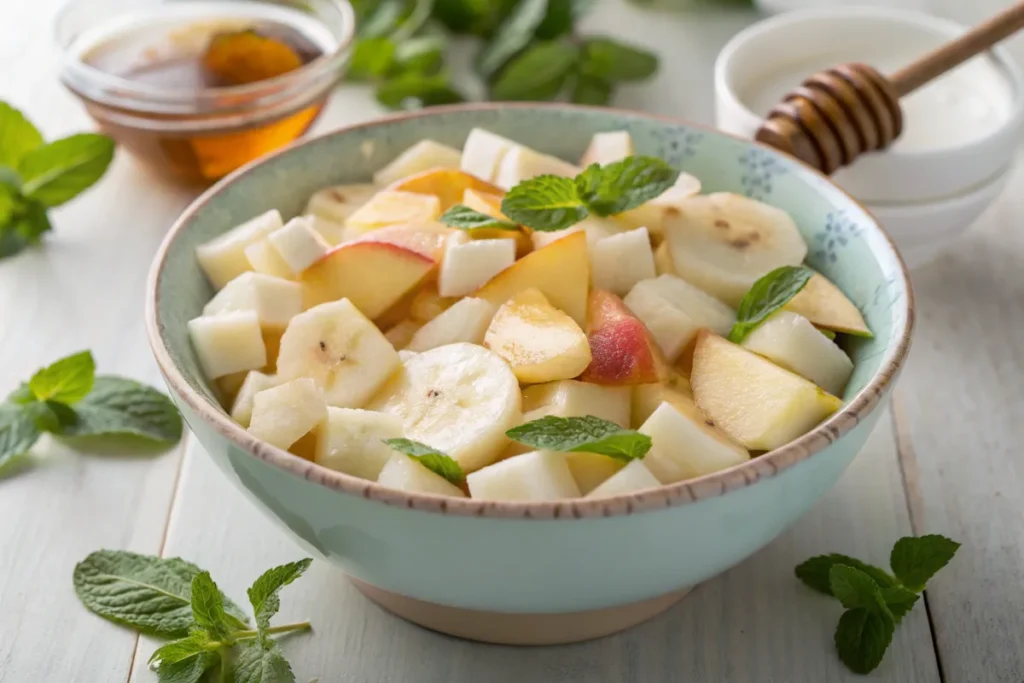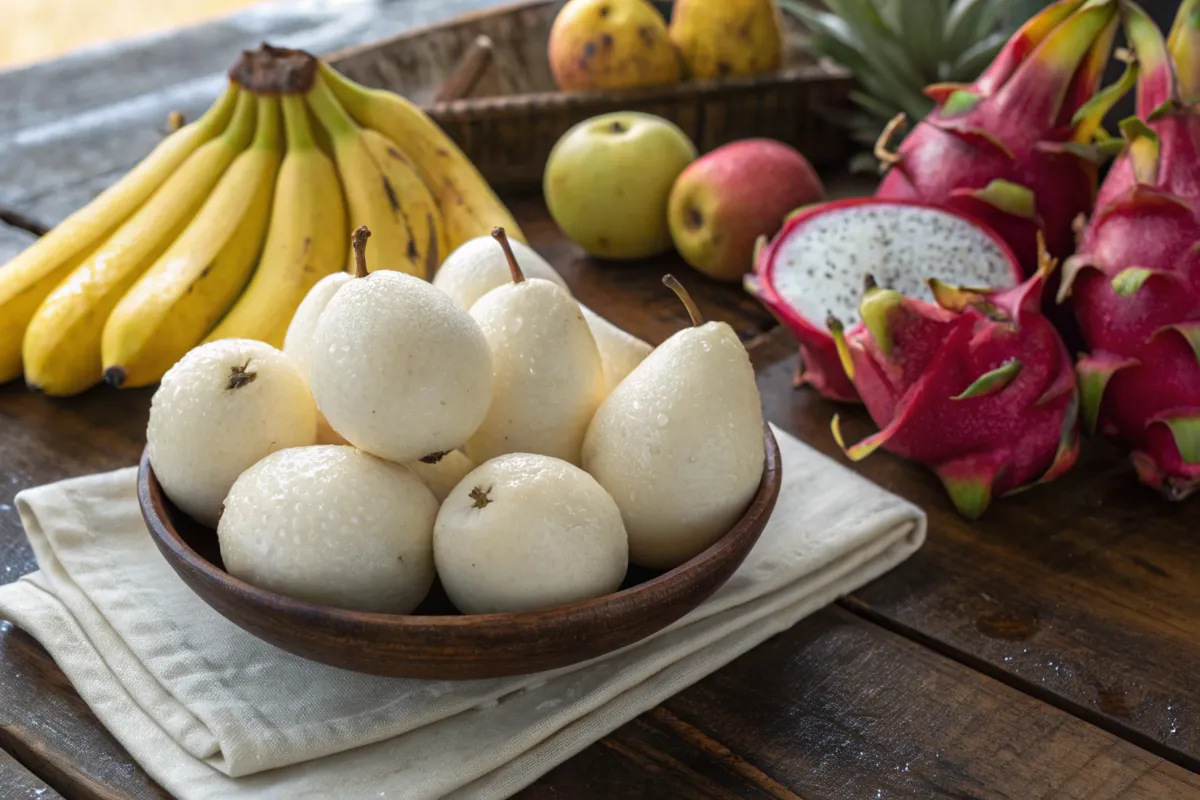White fruits are often overshadowed by their more colorful counterparts, but they are just as vital for a balanced and healthy diet. This article dives deep into the world of white fruits, exploring their unique health benefits, popular varieties, and diverse culinary uses. From their role in traditional medicine to their impact on sustainable farming, you’ll gain a comprehensive understanding of these pale-hued wonders. Whether you’re a foodie, a health enthusiast, or simply curious, this guide has something for everyone. Let’s uncover the charm and goodness of white fruits!
Introduction to White Fruits

What Are White Fruits?
White fruits are fruits characterized by their pale, ivory, or translucent flesh or skin. Unlike the vivid reds and greens of other fruits, white fruits stand out for their subtle hues and gentle sweetness. Examples include bananas, pears, white peaches, and tropical delights like dragon fruit with white flesh. These fruits are more than just visually appealing; they pack a nutritional punch.
Why Are White Fruits Unique?
What makes white fruits unique is their balance of flavor and versatility. They contain bioactive compounds like flavonoids and antioxidants that contribute to overall health. Plus, their mild flavors make them a favorite in both sweet and savory dishes. For instance, the juicy crispness of a pear or the creamy sweetness of a banana is unmatched.
The Importance of Including White Fruits in Your Diet
Including white fruits in your diet isn’t just about variety; it’s about reaping significant health benefits. These fruits are often rich in potassium, fiber, and vitamin C, making them essential for heart health and digestion. Moreover, their subtle sweetness and texture enhance recipes ranging from smoothies to salads. By adding white fruits to your meals, you’re embracing both flavor and nutrition in one delightful bite.
The Incredible Health Benefits
Packed with Essential Nutrients
Fruits like bananas, pears, and white peaches are nutrient-rich options. They offer potassium, vitamin C, and dietary fiber that promote overall health. Bananas, for example, support muscle function with their high potassium content, while pears are a great source of fiber to aid digestion.
Supporting Heart Health Naturally
The potassium in fruits such as bananas and peaches helps regulate blood pressure, reducing the risk of stroke and heart disease. Additionally, their low sodium content makes them an ideal choice for maintaining cardiovascular wellness.
Boosting Immunity with Vitamin C
Exotic fruits like lychee and dragon fruit are loaded with vitamin C, which strengthens the immune system and aids in collagen production. These nutrients are vital for warding off infections and keeping skin healthy and glowing.
Antioxidants for a Healthier You
Antioxidants, including flavonoids and polyphenols, are abundant in fruits like pears and white grapes. These compounds combat oxidative stress, reducing inflammation and the risk of chronic diseases.
Must-Try Varieties for Your Plate
Everyday Favorites
Bananas and pears are household staples known for their versatility and natural sweetness. Bananas are perfect for energy-boosting snacks, while pears add texture and flavor to salads and desserts. White peaches, with their delicate taste, make excellent additions to baked goods like tarts.
Exploring Tropical Gems
Expand your palate with exotic options like dragon fruit, lychee, and rambutan. Dragon fruit adds a tropical flair to smoothies, lychee bursts with sweetness, and rambutan’s creamy texture is ideal for desserts. These fruits provide unique flavors and impressive nutrition.
When to Buy for Maximum Freshness
Understanding seasonal availability ensures you enjoy these fruits at their peak. Pears are at their best from late summer to fall, while white peaches thrive in midsummer. For exotic varieties, lychee is typically available in spring and early summer.
The Incredible Health Benefits
Packed with Essential Nutrients
Fruits like bananas, pears, and white peaches are nutrient-rich options. They offer potassium, vitamin C, and dietary fiber that promote overall health. Bananas, for example, support muscle function with their high potassium content, while pears are a great source of fiber to aid digestion.
Supporting Heart Health Naturally
The potassium in fruits such as bananas and peaches helps regulate blood pressure, reducing the risk of stroke and heart disease. Additionally, their low sodium content makes them an ideal choice for maintaining cardiovascular wellness.
Boosting Immunity with Vitamin C
Exotic fruits like lychee and dragon fruit are loaded with vitamin C, which strengthens the immune system and aids in collagen production. These nutrients are vital for warding off infections and keeping skin healthy and glowing.
Antioxidants for a Healthier You
Antioxidants, including flavonoids and polyphenols, are abundant in fruits like pears and white grapes. These compounds combat oxidative stress, reducing inflammation and the risk of chronic diseases.
Must-Try Varieties for Your Plate
Everyday Favorites
Bananas and pears are household staples known for their versatility and natural sweetness. Bananas are perfect for energy-boosting snacks, while pears add texture and flavor to salads and desserts. White peaches, with their delicate taste, make excellent additions to baked goods like tarts.
Exploring Tropical Gems
Expand your palate with exotic options like dragon fruit, lychee, and rambutan. Dragon fruit adds a tropical flair to smoothies, lychee bursts with sweetness, and rambutan’s creamy texture is ideal for desserts. These fruits provide unique flavors and impressive nutrition.
When to Buy for Maximum Freshness
Understanding seasonal availability ensures you enjoy these fruits at their peak. Pears are at their best from late summer to fall, while white peaches thrive in midsummer. For exotic varieties, lychee is typically available in spring and early summer.
For more ideas on incorporating fruits into your meals, explore elderberry tea recipes for a delightful pairing.
Culinary Uses of Light-Hued Fruits

Sweet Treats with Fruits
Light-colored fruits bring natural sweetness and texture to a variety of desserts. Pears, for instance, are delightful when poached with spices, while peaches add elegance to fruit tarts and cobblers. Bananas are a classic choice for puddings, cakes, or even banana bread. For a quick dessert, pair sliced fruits with whipped cream or drizzle them with honey.
Savory Recipes That Shine
Pale-hued fruits also excel in savory dishes. Pears provide a crisp contrast in salads, pairing wonderfully with nuts and greens. Dragon fruit, with its subtle flavor, works well in tropical salsas or as a topping for grilled fish. Bananas, while sweet, bring a unique twist to curries, and peaches make excellent glazes for meats like chicken or pork.
Refreshing Drinks and Smoothies
Blending these fruits into beverages creates refreshing drinks perfect for any season. Bananas form the creamy base for smoothies, often paired with berries or mango. Grapes can be juiced for a naturally sweet drink, while dragon fruit adds a tropical touch to mocktails. Enhance these creations with a splash of elderberry tea for a boost of antioxidants and flavor.
For more culinary inspiration, explore other fruity recipes on the Giddy Recipes website.
White Fruits for Skin and Hair Care
Benefits of White Fruits for Skin Health
The antioxidants and vitamins in white fruits make them a favorite in skincare. Vitamin C, found in lychee and white grapes, promotes collagen production, giving your skin a firm and radiant glow. Additionally, the hydrating properties of dragon fruit and pears help keep your skin supple and moisturized.
How White Fruits Improve Hair Strength and Shine
Potassium-rich fruits like bananas are excellent for hair health. They help maintain scalp hydration and strengthen hair follicles, reducing breakage. Pears, with their antioxidant content, protect hair from environmental stressors. Including these white fruits in your diet—or even using them in DIY hair masks—can lead to shinier, healthier locks.
DIY Face Masks and Hair Treatments Using White Fruits
Creating simple DIY treatments with white fruits is easy and cost-effective. A mashed banana and honey mask can deeply condition hair, while a pear puree combined with yogurt works wonders for hydrating dry skin. Dragon fruit pulp applied directly to the face soothes irritation and improves texture.
White Fruits in Traditional Medicine
Ayurvedic Uses of White Fruits
In Ayurveda, white fruits hold a special place due to their cooling and hydrating properties. Fruits like pears and white grapes are often recommended for balancing Pitta dosha, which governs heat and metabolism in the body. Pears, with their high water content, are believed to soothe inflammation and promote digestion. Similarly, bananas are considered a calming fruit that supports gut health and energy balance.
White Fruits in Chinese Medicine
Traditional Chinese Medicine (TCM) values white fruits for their ability to nourish the lungs and clear heat. Lychee, for instance, is believed to improve energy (Qi) and strengthen the body. White peaches are known for their detoxifying properties, while dragon fruit is thought to boost immunity and aid digestion. TCM often incorporates these fruits in teas, soups, or eaten fresh to harness their full benefits.
Modern Applications in Nutraceuticals
In modern medicine, the therapeutic properties of white fruits are gaining recognition. Extracts from fruits like white grapes and dragon fruit are now used in nutraceutical products for their high antioxidant content. These supplements aim to combat oxidative stress, reduce inflammation, and support heart health, showing how ancient wisdom aligns with contemporary science.
Sustainability and Ethical Considerations
Sustainable Farming of White Fruits
Sustainability is key when it comes to cultivating white fruits. Many of these fruits, such as bananas and dragon fruit, thrive in tropical climates where sustainable practices like crop rotation and organic farming are becoming more common. These methods not only protect the environment but also ensure higher-quality produce.
Ethical Sourcing and Fair Trade Practices
Ethical sourcing is equally important in the world of white fruits. Fair Trade-certified bananas, for example, guarantee that farmers are paid fairly and work under safe conditions. By supporting ethically sourced fruits, consumers can contribute to improving lives and fostering sustainable agricultural communities.
Environmental Impact of Growing White Fruits
Growing white fruits can be environmentally friendly when done responsibly. Many of these fruits require minimal pesticides and thrive in biodiverse environments. However, monocropping and excessive water usage can pose challenges. Supporting local and eco-conscious producers helps mitigate these issues while reducing the carbon footprint associated with transportation.
FAQs About White Fruits
What Are the Best Fruits for Weight Loss?
If you’re looking to manage your weight, options like pears and bananas are fantastic choices. Pears are low in calories and high in fiber, helping you stay full longer and reducing the urge to snack. Bananas, while slightly more calorie-dense, offer a quick energy boost and help curb cravings. Another great choice is dragon fruit, with its high water content and low sugar levels, making it ideal for weight-conscious diets.
Are Light-Colored Fruits as Nutritious as Others?
Absolutely! While brightly colored fruits often get the spotlight, pale varieties are just as nutritious. For example, grapes with white or green skins contain powerful antioxidants, and lychee is packed with vitamin C. Bananas provide ample potassium, and pears are a rich source of dietary fiber. Including these fruits ensures a well-rounded and balanced diet.
Can These Fruits Trigger Allergies?
Although uncommon, some people might experience mild reactions to fruits like lychee or bananas. Symptoms could include itching, swelling, or stomach discomfort. If you suspect a reaction, it’s best to seek advice from a healthcare provider before adding them to your meals.
What’s the Best Way to Store Them?
Proper storage is key to enjoying fruits at their freshest. Bananas are best kept at room temperature, while pears and grapes should go in the fridge to stay crisp. For long-term use, slice and freeze fruits like dragon fruit or bananas to use in smoothies or desserts.
Conclusion: Why White Fruits Deserve a Spot in Your Diet
White fruits may lack vibrant colors, but their subtle charm and robust health benefits make them a must-have in any diet. From their high antioxidant content to their ability to promote heart health and boost immunity, these pale-hued fruits are nutritional powerhouses. Whether it’s the crisp sweetness of a pear, the tropical flair of dragon fruit, or the creamy texture of a banana, each fruit offers unique flavors and versatility.
Moreover, white fruits are not just about taste and nutrition—they play an important role in sustainability and ethical farming. By choosing Fair Trade bananas or locally grown dragon fruits, you’re not only nourishing your body but also supporting environmentally friendly and socially conscious practices.
Incorporating white fruits into your meals is simple and satisfying. Add them to smoothies, salads, or even baked dishes for a burst of flavor and nutrition. So, next time you’re at the market, don’t overlook these underrated gems. They’re proof that nutrition and deliciousness can come in every shade, even white!

